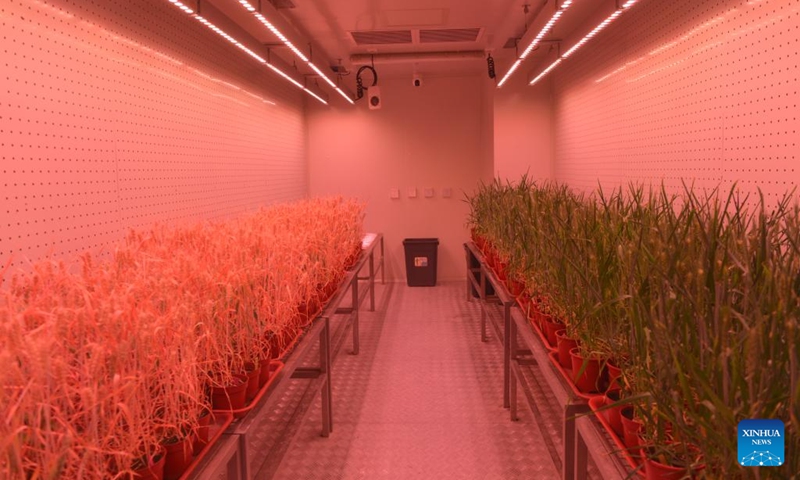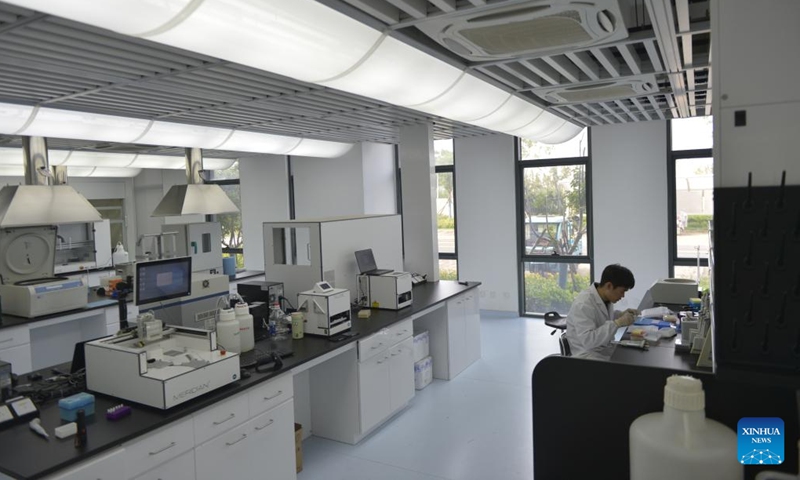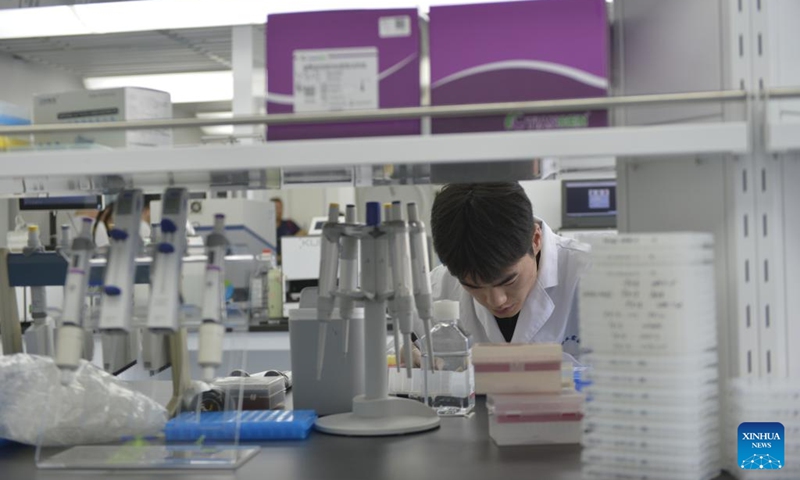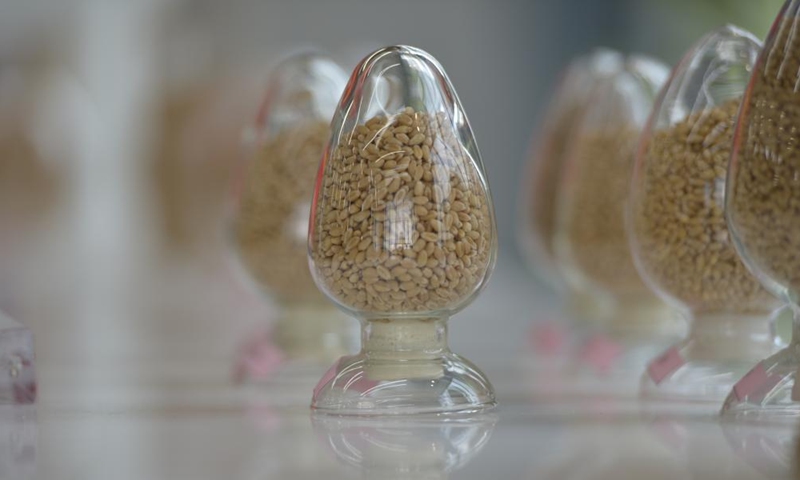
This photo taken on May 31, 2024 shows two groups of wheats bred for comparison at a laboratory of Central-China Agricultural Valley, an agricultural innovation platform, in central China's Henan Province. (Photo: Xinhua)

A researcher works at a laboratory of Central-China Agricultural Valley, an agricultural innovation platform, in central China's Henan Province, May 31, 2024. (Photo: Xinhua)

A researcher works at a laboratory of Central-China Agricultural Valley, an agricultural innovation platform, in central China's Henan Province, May 31, 2024. (Photo: Xinhua)

This photo taken on May 31, 2024 shows seed samples at a laboratory of Central-China Agricultural Valley, an agricultural innovation platform, in central China's Henan Province. (Photo: Xinhua)
This wheat harvest season, Ma Wenchang has received frequent messages about weather conditions, soil moisture levels and optimal harvest times. After inspecting his fields, he was able to assemble eight combine harvesters and harvest 2,000 mu (about 133.33 hectares) of wheat in just two days.
The messages are sent by the local department of agriculture, and they are crucial for grain farmers like Ma in Xinxiang City, central China's Henan Province, as wheat is vulnerable to poor conditions in the harvest season.
In one of Ma's wheat fields, a pole equipped with solar panels, high-definition cameras and atmospheric sensors catches the eye. The "smart pole" also has soil sensors buried beneath it.
These instruments transmit various data continuously to the "digital brain" of the Central-China Agricultural Valley, which is an agricultural innovation platform developed by Henan. Centered on breeding, it also focuses on the development of smart agriculture and the construction of high-standard farmlands. Its digital brain processes information related to weather, soil moisture, soil fertility and crop conditions through various data models, and then sends it to farmers to assist with agricultural production.
The digital brain provides computational support for the Central-China Agricultural Valley. It currently houses four major data models for weather, soil, fertility and plant transpiration, having collected remote-sensing satellite data and over 200 million data points from more than 20 smart poles across 10 monitoring stations in Xinxiang City.
"This innovative approach enhances agricultural informatization using industrial-internet thinking. However, agriculture differs from industry as many aspects are not standardized, so our four major models are still in training. It may take years of data accumulation to understand the patterns," said Yin Yue, the digital brain project manager.
There will be 200 smart poles by the end of June, feeding more data into the four models, Yin said.
The agricultural valley platform operates mainly in Xinxiang City, covering a planned area of 1,612 square kilometers. It hosts 74 seed enterprises and 53 research platforms at the provincial level or higher.
Central China encompasses parts of Shanxi, Henan, Hubei, Hunan, Anhui and Jiangxi provinces, and is a key grain production base in the country. Henan is China's most significant wheat-producing province, accounting for a quarter of the national output, while Hunan has the largest rice-planting area in the country, exceeding 59 million mu.
In recent years, central China has promoted agricultural development through technological innovation, establishing agricultural innovation demonstration zones and facilities such as the agricultural valley platform, "seed valley" and organic dry-farming areas to elevate agricultural development.
Hunan leads the nation in rice-breeding and was home to Yuan Longping, who made significant contributions to rice-breeding in China and is known as the "father of hybrid rice."
Today, Hunan is home to companies like Longping High-Tech, as well as multiple agricultural academicians and national innovation platforms, including a national key laboratory for hybrid rice. The province is now working to build a "seed valley."
"Our new 'Liliangyou 8022' variety yielded our target of 1,251.5 kilograms per mu in Dechang County, Sichuan Province," said Xu Qiusheng, a researcher at the Hunan Hybrid Rice Research Center.
The center has made breakthroughs in the production of super rice seeds. In 2022, it achieved a seed yield of 459.07 kilograms per mu in Jianning County of Sanming City, east China's Fujian Province. The national average hybrid rice seed yield was about 150 kilograms per mu at the time -- a third of the center's yield.
"This not only means we can produce more seeds, but it also reduces farmers' production costs significantly, by about 30 percent," Xu said.
In north China's Shanxi Province, where mountains and hills account for 80 percent of the total area, the promotion of organic dry-farming technology has increased yields in many rain-dependent areas and reduced agricultural machinery operations costs.
In Zhangzi County, Shanxi, grain farmer Wang Jiantang's corn seedlings are already 50-60 centimeters high, despite lower-than-usual rainfall. Since last year, Wang has been using organic dry-farming technology.
Before introducing the new technology, his seedlings would not have done as well as they have this year without much rain, and some might not even have sprouted. After testing the technology last year, he is confident about this year's harvest.
"Last year, the new technology, combined with good rainfall, increased the grain yield by more than 50 kilograms per mu," he said. By integrating multiple steps into the sowing process, he reduced the use of agricultural machinery threefold, saving over 100 yuan per mu.
In 2023, Zhangzi County used organic dry farming technology on 8,071 mu of fields, with changes including no-till features and increased soil moisture, nutrients and density. This resulted in an average yield increase of 51.6 kilograms per mu.
The technology is significant to rain-dependent, arid farming areas facing soil erosion and rainfall challenges. It addresses the issues of spring droughts and low rainfall that hinder sowing or seedling emergence. By integrating multiple conservation tillage techniques, it ensures stable grain production while protecting the land, according to local agricultural officials.
"The application of new varieties and technologies has cultivated new advantages to ensure food security in central China, and is of great significance to the innovative development of Chinese agriculture," said Guo Tiancai, a professor at Henan Agricultural University.







